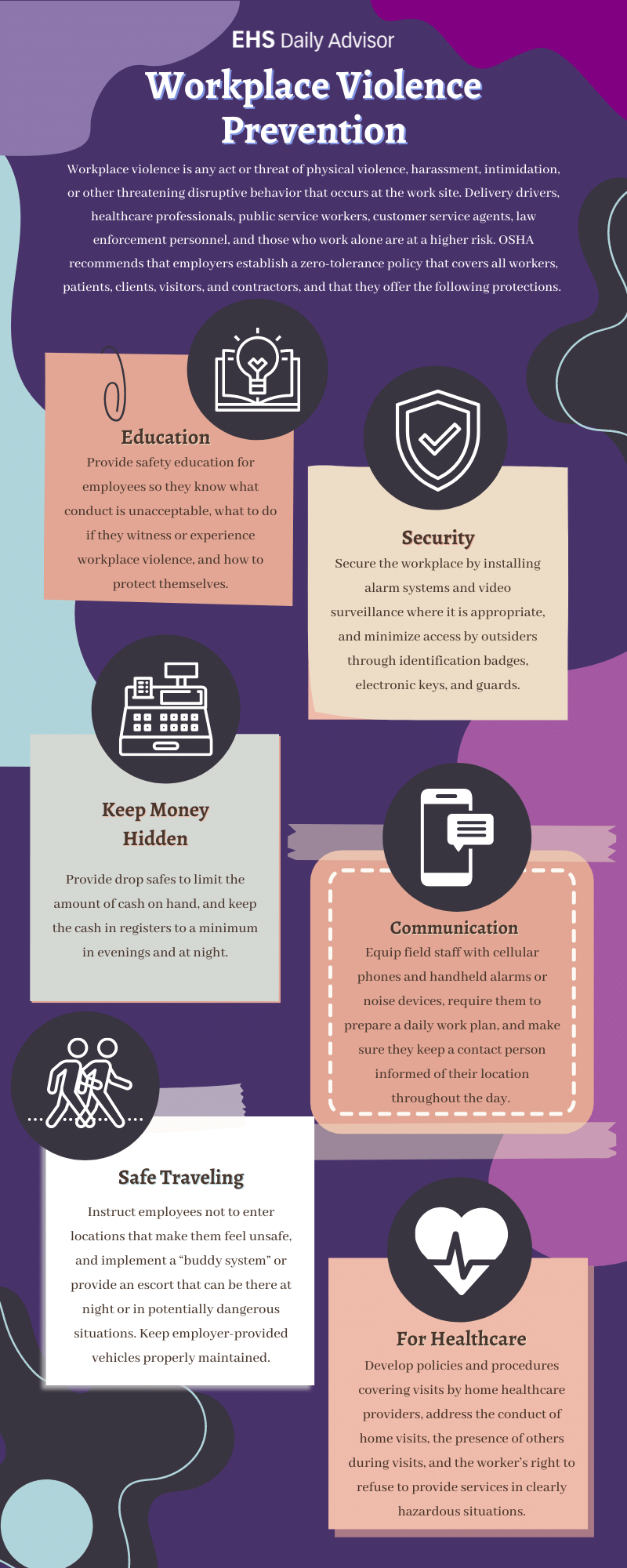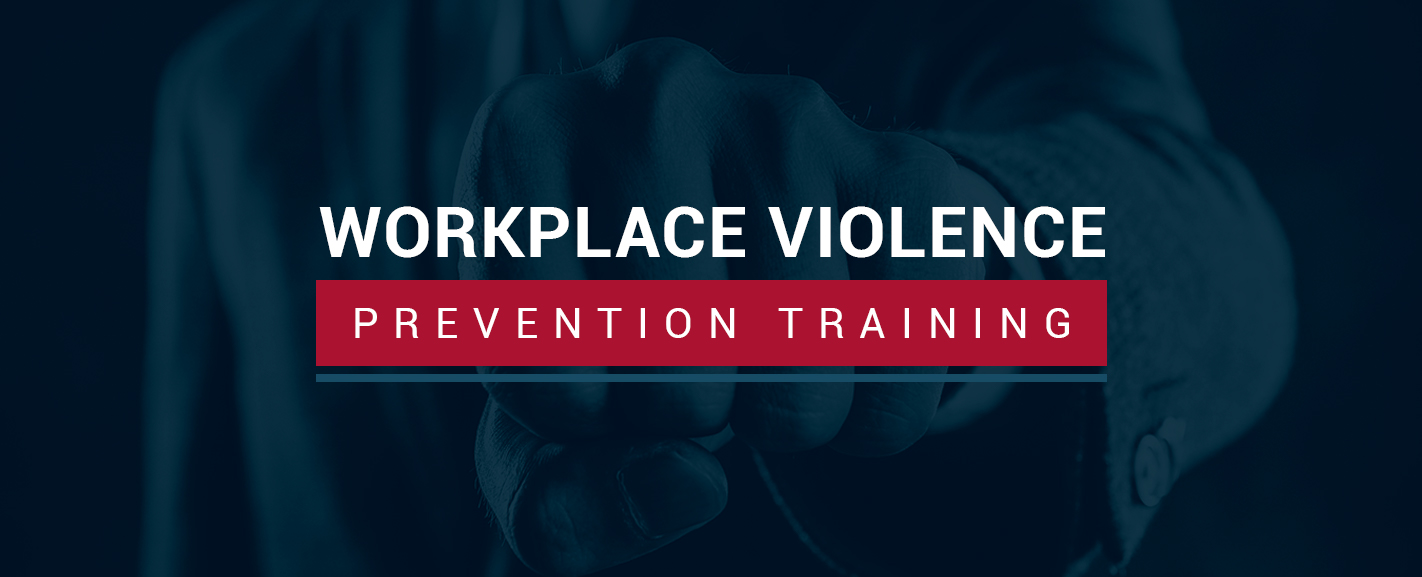Just how to Assess the Effectiveness of Your California Workplace Violence Prevention Initiatives
Just how to Assess the Effectiveness of Your California Workplace Violence Prevention Initiatives
Blog Article
Assessing the Influence of Work Environment Society on the Success of Physical Violence Avoidance Efforts and Employee Well-Being
The crossway of workplace culture, violence prevention efforts, and worker wellness warrants careful assessment, as these aspects jointly affect organizational success. A society that focuses on open communication and emotional safety can encourage staff members to determine and report potential threats, consequently fostering a setting for both psychological wellness and efficient violence prevention approaches. Nonetheless, the nuances of just how these aspects engage continue to be multifaceted and complicated. Understanding the certain devices at play can expose critical insights that may notify future efforts and drive meaningful adjustment within companies. What hidden dynamics may be affecting these results?
Comprehending Work Environment Culture
Regularly, workplace culture works as the foundation for staff member communications and general business habits. It includes the common worths, ideas, and methods that form the setting in which staff members run. A favorable workplace culture promotes cooperation, respect, and open communication, while a negative culture might reproduce tension, question, and hostility. Comprehending workplace culture is important for companies intending to execute effective physical violence prevention strategies.

Organizations have to analyze their present office society to identify locations for enhancement. This analysis can include studies, focus groups, or one-on-one discussions. By recognizing the social dynamics at play, organizations can apply targeted interventions that advertise a more secure and much more considerate job setting, inevitably minimizing the danger of physical violence in the workplace.
Duty of Employee Wellness
A favorable office culture not just affects business behavior but additionally significantly influences staff member well-being. When staff members feel valued and appreciated, their overall work satisfaction increases, causing improved mental and psychological wellness. This, subsequently, promotes a feeling of belonging and commitment, which is crucial for long-lasting interaction and productivity.
Additionally, a supportive social environment promotes open communication, making it possible for workers to share worries and seek aid without worry of stigma. This openness is crucial in dealing with concerns associated with tension, burnout, and social disputes, which can adversely influence both individual health and organizational harmony.
In addition, companies that prioritize employee well-being commonly see lowered absence and turnover prices. Healthy and balanced workers are more resilient and much better furnished to deal with work environment difficulties, adding to a more efficient and steady workforce.
Purchasing employee health through campaigns such as health cares, mental health resources, and flexible working arrangements can develop a favorable feedback loop, enhancing both private fulfillment and cumulative organizational success (california workplace violence prevention). Ultimately, focusing on employee health is not merely an ethical imperative; it is a critical approach that benefits the whole organization
Physical Violence Avoidance Strategies
Executing efficient violence prevention techniques is essential for preserving a healthy and safe workplace setting. Organizations has to take on an extensive technique that includes policy advancement, worker training, and proactive interaction. Establishing clear workplace physical violence plans is the initial action, making sure that all staff members comprehend acceptable habits and the consequences of infractions.
Educating programs need to be developed to educate employees about recognizing warning signs of prospective physical violence, problem resolution techniques, and emergency action treatments. Normal drills and simulations can boost great post to read readiness, cultivating a society of awareness and responsibility.
Furthermore, fostering open communication networks encourages workers to report issues without worry of retaliation. This can be helped with via confidential coverage systems or routine comments sessions. Advertising a helpful workplace society that values regard and inclusivity can considerably minimize the threat of physical violence.
Organizations should additionally take part in normal analyses of their workplace society and physical violence avoidance strategies, adapting them to progressing demands. By prioritizing these strategies, companies not just secure their employees but likewise boost overall well-being, eventually adding to a more effective work environment.
Determining Cultural Influence
Measuring the effect of workplace culture on physical violence prevention efforts is crucial for understanding the efficiency of existing techniques and determining locations for improvement - california workplace violence prevention. To accomplish this, companies must employ a diverse method that combines qualitative and measurable techniques. Analyses and surveys can gather data on staff member assumptions of workplace support, inclusivity, and security systems, while incident reports offer concrete proof of violence occurrences and their context within the business society
In addition, focus teams and interviews can expose much deeper understandings right into employees' attitudes, ideas, and experiences surrounding violence prevention efforts. Examining this qualitative data aids organizations to determine social staminas and weak points that may either help with or hinder efficient avoidance techniques. Furthermore, benchmarking versus market criteria enables relative analysis, aiding companies determine their efficiency family member to peers.

Creating Helpful Settings
Frequently promoting a supportive environment within the office is necessary for efficient violence prevention. Such settings encourage employees to interact honestly concerning their experiences and issues, therefore identifying potential issues before they escalate. A society of assistance enhances count on amongst group members, motivating cooperation and aggressive analytic.
To develop an encouraging atmosphere, organizations need to focus on training programs that concentrate on conflict resolution, emotional intelligence, and active listening. These abilities gear up workers to manage interpersonal partnerships constructively, minimizing the likelihood of misconceptions that might cause physical violence - california workplace violence prevention. In addition, get more implementing mentorship programs can supply employees with guidance and confidence, contributing to their general well-being
Management plays a crucial duty in shaping a supportive workplace society. By modeling empathetic behavior and demonstrating a dedication to staff member well-being, leaders established a tone that urges others to do the same. Regular comments devices, such as anonymous surveys, can likewise help assess staff member sentiment and highlight areas for enhancement.
Ultimately, a supportive environment not just minimizes the risk of violence but also enhances worker spirits, task satisfaction, and productivity, strengthening the organization's dedication to fostering a safe and successful office.
Conclusion
A positive office culture significantly influences both violence prevention initiatives and staff member well-being. By fostering open communication and urging the coverage of issues, companies can enhance mental health and work complete satisfaction amongst workers. A supportive society enhances the efficiency of physical violence prevention techniques by resolving and promoting the prompt acknowledgment of caution indicators. Ultimately, cultivating such an atmosphere acts as a vital foundation for effective interventions and contributes to the total success of the organization.
The crossway of workplace society, violence prevention initiatives, and staff member wellness warrants cautious assessment, as these components collectively influence organizational success. A society that prioritizes open communication and emotional security can encourage workers to recognize and report prospective dangers, thus promoting a setting favorable to both psychological health and reliable physical violence prevention techniques.A favorable work environment culture not just influences organizational actions but likewise significantly impacts employee well-being. read this Studies and assessments can collect information on worker understandings of workplace safety and security, inclusivity, and support systems, while occurrence reports supply concrete evidence of physical violence occurrences and their context within the business society.
A positive office culture substantially affects both physical violence avoidance initiatives and staff member wellness.
Report this page